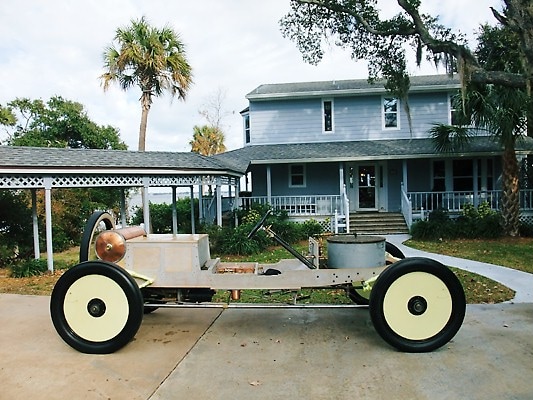|
UPDATE ON RAY STANLEY THREE PASSENGER 30HP ROADSTER Restoration by Brent Campbell Basil and Vicki visited with Martha and me last month while they were at their vacation home in Orlando, Florida. They came over for a visit and got to see the progress since their visit last year. You will remember that this is a recreation of the second vehicle of three Stanley’s that was built expressly for FE’s only son, Raymond. Ray designed each one (he graduated from Harvard with a degree in automobile design.) You will recall that this car was dismantled after two steering failures so we know it did not survive. Computer enhancement of the six pictures of it that came from Ray’s photo scrap book enabled my son-in-law to accurately replicate this car. I was blessed with many of the correct key components from Stanley parts gathered over the past forty years. The correct 30hp engine, front and rear axles, all pumps, valves, gages, automatics, original fittings, lamps, etc. gave me what Carl Amsley would have termed “A license to build”. Other hard to find items such as an original engine case, oil tank, correct roadster pedals, and all the leaf springs necessary to make a set were also procured or bartered for in some cases. Absolutely every part has been rebuilt before installation. Since my last report a new aluminum body was constructed around the wooden skeleton that Mark and his employee, Peter Kruger had formed. Much of the paint work has now been done. Don Bourdon recently painted the body and Loren Burch is doing the upholstery as this is being written. I completed the plumbing and all the necessary components were installed with the goal of having a running chassis. It often takes me a considerable amount of time to get a “new” car dialed in to run up to snuff. Making myriads of adjustments is much easier without dealing with painted body, fenders, hood, etc. It is also much easier to make improvement when these items are not in the way and there is no worry about scratched paint. The chassis was ready for a test drive in August. Over 500 miles have been accumulated with the aid of a compact GPS device about the size of a pack of cigarettes. Every test drive yields advancement and I am getting closer to a Stanley that performs properly. This vehicle has a 130 inch wheelbase [same as most condensers] and I am impressed with the ease of steering, excellent ride, and very good handling characteristics. Most Stanley’s under steer when cornering with few exceptions [a model H is a notable exception]. This car has a 55 gallon water tank located behind the passenger compartment, a 20 gallon fuel tank, pilot tank, and the engine hanger strap just below your rear end. All this weight in the rear makes for ideal weight distribution. In order to get the car as low as Raymond desired [it is almost 9 inches lower than a production car] the boiler and burner were located behind the front axle to eliminate bottoming out due to normal suspension travel The steering tie rod is modified so as to be under the perch poles instead of above them. The springs were moved to the outside and at the top of the frame rails instead of underneath. These are just a few of the changes that were made to achieve the desired height. While we were blessed with various external pictures there were none of the “innards” that showed how the numerous modifications were made to achieve the original design. This has made construction much more difficult than copying a regular production car where proper measurements, attention to authenticity of components, and assembly can result in a proper reproduction. Few assembled cars I have studied come close to being a correct, authentic reproduction. Most folks don’t take the time to research or bother to reproduce parts exactly so as to achieve an accurate finished product. {Basil Craske is one of the few exceptions. He takes the time to research, study original survivors, make and procure correct pieces, and pays close attention to accurate fit and finish to achieve an accurate result. Deviations are limited to improve practical drivability, and safety issues such as modern brakes and lighting. These are areas where owners that use their cars regularly consider these modifications absolutely necessary.} At the moment a feed water heater fabricated by Don Bourdon is being installed in the exhaust duct which should improve performance considerably. This is a much heavier car than “Effie” [the first car expressly made for Ray Stanley which did survive and I feel blessed to be its current custodian]. I don’t expect it will have the same level of performance since it will be about 650 pounds heavier when finished. My plan is to continue having fun with it in chassis form until fall before the body is installed. It will come back down to Florida again next November and the lamps, electrification, and speedometer installation will be projects for next winter. It should be completed by next spring. In the mean time I will attend at least three tours and put as many miles on the chassis as I can. Driving it in chassis form is a blast and performance is more exciting than when it is in full dress at maximum curb weight. Most people who see the original pictures from Ray Stanley’s photo scrap book don’t like it’s peculiar look due to the after market wheel discs and the unusual canvas windscreen. I hope it will be more appealing in the “flesh” since it is so low and very long. These attributes are not readily apparent in the original pictures. Ray Stanley did say that this was his favorite of the cars made for him when interviewed in 1980, four years before his death. Now that it is running I can well understand why this was the car he liked the most! PART THREE TO FOLLOW SOON
0 Comments
|
Archives
December 2022
Categories
All
|
|
|
Steam Car Network functions as a resource for all steam car and steam bike enthusiasts. The website is constantly updated with articles, events, and informative posts to keep the community alive and growing. Feel free to contact us if you have any questions or concerns at the email address below and we will promptly reply.
[email protected] |



 RSS Feed
RSS Feed
